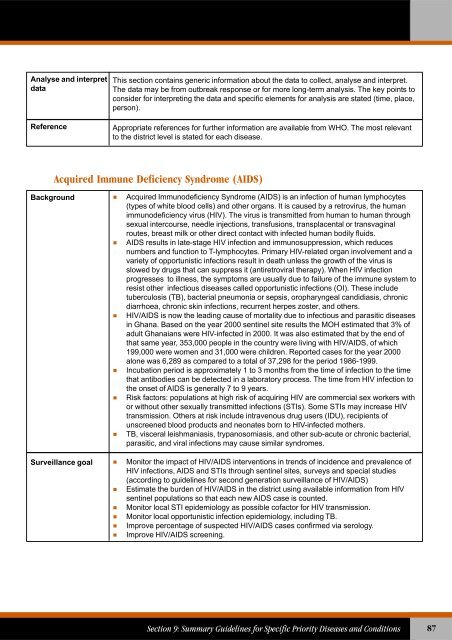Technical Guidelines for Integrated Disease Surveillance ... - PHRplus
Technical Guidelines for Integrated Disease Surveillance ... - PHRplus
Technical Guidelines for Integrated Disease Surveillance ... - PHRplus
You also want an ePaper? Increase the reach of your titles
YUMPU automatically turns print PDFs into web optimized ePapers that Google loves.
Analyse and interpretdataReferenceThis section contains generic in<strong>for</strong>mation about the data to collect, analyse and interpret.The data may be from outbreak response or <strong>for</strong> more long-term analysis. The key points toconsider <strong>for</strong> interpreting the data and specific elements <strong>for</strong> analysis are stated (time, place,person).Appropriate references <strong>for</strong> further in<strong>for</strong>mation are available from WHO. The most relevantto the district level is stated <strong>for</strong> each disease.Acquired Immune Deficiency Syndrome (AIDS)Background Acquired Immunodeficiency Syndrome (AIDS) is an infection of human lymphocytes(types of white blood cells) and other organs. It is caused by a retrovirus, the humanimmunodeficiency virus (HIV). The virus is transmitted from human to human throughsexual intercourse, needle injections, transfusions, transplacental or transvaginalroutes, breast milk or other direct contact with infected human bodily fluids. AIDS results in late-stage HIV infection and immunosuppression, which reducesnumbers and function to T-lymphocytes. Primary HIV-related organ involvement and avariety of opportunistic infections result in death unless the growth of the virus isslowed by drugs that can suppress it (antiretroviral therapy). When HIV infectionprogresses to illness, the symptoms are usually due to failure of the immune system toresist other infectious diseases called opportunistic infections (OI). These includetuberculosis (TB), bacterial pneumonia or sepsis, oropharyngeal candidiasis, chronicdiarrhoea, chronic skin infections, recurrent herpes zoster, and others. HIV/AIDS is now the leading cause of mortality due to infectious and parasitic diseasesin Ghana. Based on the year 2000 sentinel site results the MOH estimated that 3% ofadult Ghanaians were HIV-infected in 2000. It was also estimated that by the end ofthat same year, 353,000 people in the country were living with HIV/AIDS, of which199,000 were women and 31,000 were children. Reported cases <strong>for</strong> the year 2000alone was 6,289 as compared to a total of 37,298 <strong>for</strong> the period 1986-1999. Incubation period is approximately 1 to 3 months from the time of infection to the timethat antibodies can be detected in a laboratory process. The time from HIV infection tothe onset of AIDS is generally 7 to 9 years. Risk factors: populations at high risk of acquiring HIV are commercial sex workers withor without other sexually transmitted infections (STIs). Some STIs may increase HIVtransmission. Others at risk include intravenous drug users (IDU), recipients ofunscreened blood products and neonates born to HIV-infected mothers. TB, visceral leishmaniasis, trypanosomiasis, and other sub-acute or chronic bacterial,parasitic, and viral infections may cause similar syndromes.<strong>Surveillance</strong> goal Monitor the impact of HIV/AIDS interventions in trends of incidence and prevalence ofHIV infections, AIDS and STIs through sentinel sites, surveys and special studies(according to guidelines <strong>for</strong> second generation surveillance of HIV/AIDS) Estimate the burden of HIV/AIDS in the district using available in<strong>for</strong>mation from HIVsentinel populations so that each new AIDS case is counted. Monitor local STI epidemiology as possible cofactor <strong>for</strong> HIV transmission. Monitor local opportunistic infection epidemiology, including TB. Improve percentage of suspected HIV/AIDS cases confirmed via serology.Improve HIV/AIDS screening.Section 9: Summary <strong>Guidelines</strong> <strong>for</strong> Specific Priority <strong>Disease</strong>s and Conditions87















